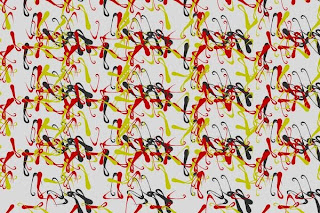Having recently seen some more of Pollock's paintings, and having read a little more about his life, I think that at last I can begin to systematize his method. This is a recent attempt. All the marks in this first image have been randomly chosen, in a way that I will describe in what follows. But first, lets look at a more regular arrangement of shapes.
[Note - there is a more recent post at Splash till Done August 2014, which refers back to this entry]
If you look carefully at this image you will possible be able to discern a repeating pattern. It's not that straightforward because in fact I have printed two repeating patterns one on top of the other slightly out of register. Again, I will analyse this arrangement in a way that may begin to explain why I think this is closer to Pollock than the random arrangement of the first image.
These images are images by systematically overprinting a "splash" in random locations and random orientations across the canvas, in a sense simulating Pollock's action of walking around the painting dripping and pouring paint onto it.
Because I was interested in the apparent uniformity in some of Pollock's paintings I have tried to reproduce near-uniformity in the images shown here. Partly that is just a side-effect of the way the randomness works. Every location and every orientation are equally likely and when you have enough samples each part of the image looks pretty much like every other part (see the top example),
But the apparent uniformity in Pollock's pictures is more considered than random. He clearly has in mind some effect he is trying to achieve, either a shadow of a realistic object (a body or a head, for example) or a symmetry of pattern that will evince some sort of reaction.
To try to achieve this more considered uniformity I have used two structural devices. The first is to apply the marks to the canvas in layers. The second is to exactly reproduce small sections of the canvas in a grid pattern. This latter structural component may seem odd given what we know about Pollock's methods. But it works, in an odd way.
The second image above paint has been applied in two layers. In each layer, three colours have been used (red, black, grey). The lower layer is a grid of 4 by 4 cells. The upper layer is a grid of 3 by 4 cells.
Thus the cells are in registration vertically, but not horizontally. You can't therefore find anywhere in the image that is exactly the same as anywhere else, but you can find echoes of one cell in its neighbours. This is similar to the pattern that Pollock's image evoke in me when I study them closely, so it is something that I think deserves further examination.
This idea of making adjacent cells slightly out of phase with their neighbours came to me when reading Steve Reich's essays in Writings on Music. His use of "phasing" in some of his early music which then developed into systematic changes in sequencing in his later compositions seemed to me to have echoes of the way that Pollock worked on adjacent sections of the same canvas using nearly-the-same actions.
Look at the following four images. They are systematically produced and systematically presented. You should be able to see the symmetries in each of them, for these are based on a grids that are exactly in phase.
All four images above have two layers each with a 4 by 4 grid. Each layer has splashes of red, black and yellow. The only difference is how many splashes. Reading from top to bottom, there are 10, 20, 40 and 80 splashes per cell.
The fact that the grids in each layer are exactly in phase (in fact, in exact registration) means that what we have produced is a very elementary wallpaper. Not so much Jackson Pollock, more William Morris.
Now look at the next four images. This time we have exactly the same number of layers (2) and exactly the same number of splashes (10, 20, 40, 80) . The only difference is that the grids are different. The lower layer has a 4 by 4 grid but the lower layer has a 5 by 4 grid.
So now the symmetries are weakened. There is only vertical symmetry.
Finally, to put both the vertical and horizontal grids out of phase, I have chosen to make the lower grid 4 by 3 and the upper grid 5 by 4 in the next set of four images.
While the last of these four still has the appearance of symmetry, close inspection will reveal that to be an illusion. It's still too close to wallpaper to be attractive, but it is interesting to see how symmetry evokes some kind of recognition that a more random arrangement seems to lack.
If we take this process to a higher level of abstraction, by using five layers rather than just two and making sure that none of them registers exactly with any other, this is what we achieve:















